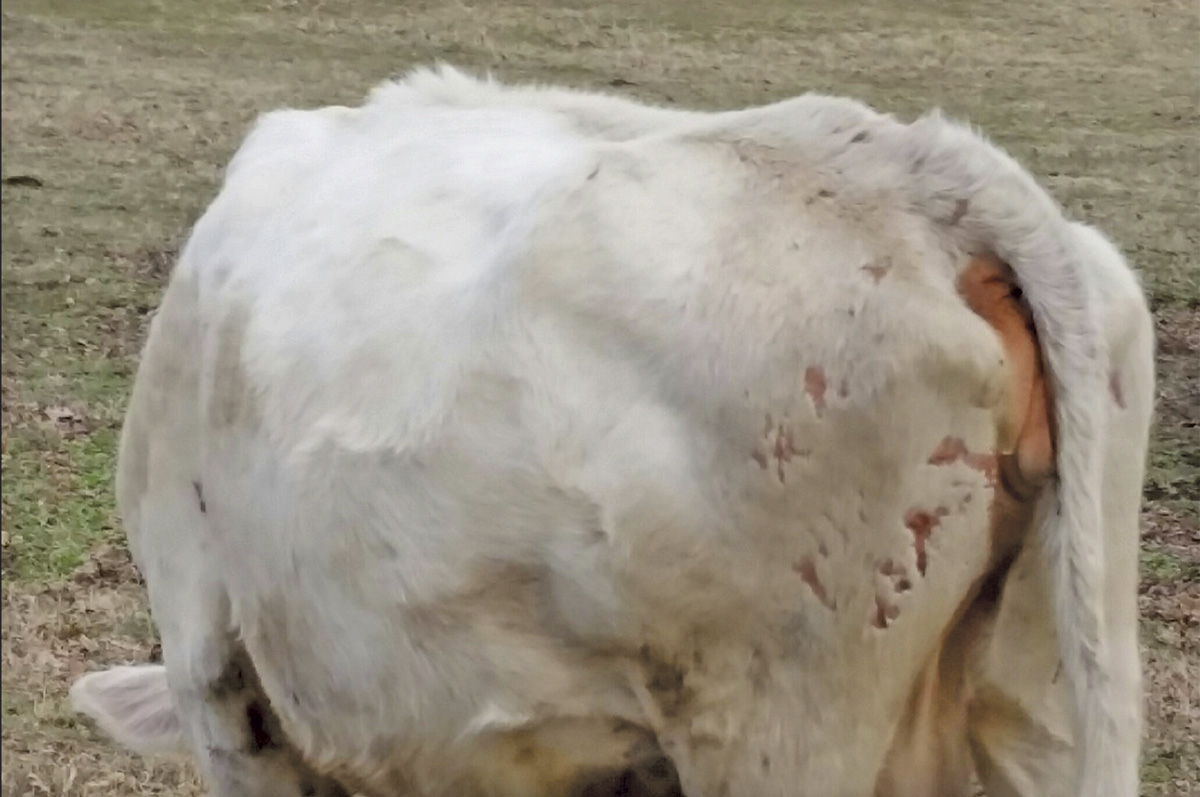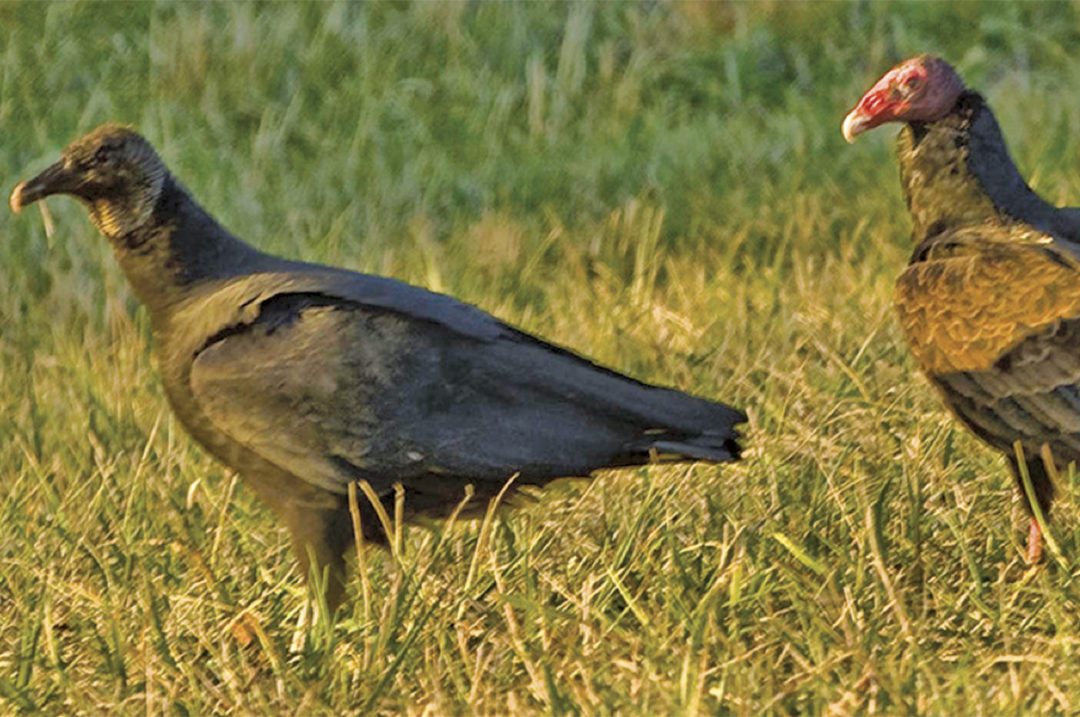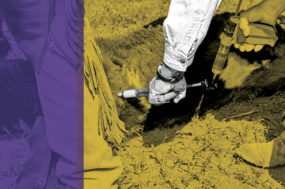In recent years, black vultures have been expanding their range northward. Common in the southeastern US., black vultures now range at least as far north as Pennsylvania and southern New England. Protected by the Migratory Bird Act, black vultures pose a unique threat to cattle producers.
Becky McPeake is a professor of wildlife extension with the University of Arkansas’s Division of Agriculture. According to McPeake, black vultures have only posed a serious problem to Arkansas cattle producers in the last 10 years. Prior to that, she says, “I don’t know that they have been here in large numbers.”
McPeake, who has a Ph.D. in human interactions with wildlife, says that the characteristics of black vultures make it likely that issues with agriculture will pop up.
“The one that has been traumatic has been their attack on calves,” says McPeake.
Although it can often be difficult to determine the cause of death of an animal being fed on by black vultures, the migratory birds are known to attack calves within the first few days of life. But because black vultures are protected by the Migratory Bird Act, controlling them can be difficult. McPeake recommends bringing cows that are about to calve into a building or at least into an area where more people and dogs are present in order to discourage black vultures, though she recognizes that this is not always feasible on many larger operations.
Black birds, red tape
The Migratory Bird Act dates to 1918 and states that certain protected birds cannot be killed without permission from the U.S. Fish and Wildlife Service.
“We’re talking multiple countries involved with the black vulture,” says McPeake, explaining that the multinational aspect of bird protection makes regulation extremely complicated.
McPeake says one possible tactic of control is to use a dead black vulture to ward off predation. “There is some evidence that an upside-down dead vulture will serve as an alarm to the other birds,” she says. Unfortunately, there is a likelihood that black vultures scared off in this manner will just move on to another location in order to find prey.
In some states, it is now possible to kill black vultures, despite their protected status. For example, the process to take some birds has gotten easier lately in Arkansas. In the past, the USDA would come out to assess the situation, and the producer would have to apply for a permit, paying $100. The process could take several weeks. Now, working with the Arkansas Farm Bureau, producers have a more streamlined way of getting permits to kill black vultures. Farm Bureaus in Arkansas and many other states east of the Mississippi can now issue permits that allow the taking of three to five black vultures.
Sen. Markwayne Mullin of Oklahoma, along with Sens. Tommy Tuberville of Alabama and Cindy Hyde-Smith of Mississippi, have recently introduced legislation (the Black Vulture Relief Act) that would allow livestock producers to kill black vultures without a permit. Mullin issued a press release in November calling the current permit system outdated.
Stephen Guertin, deputy director for policy at the U.S. Fish and Wildlife Service, has testified that the service does not support the bill, arguing that it would mean essential records and data would no longer be compiled on black vultures as the bill currently stands. Guertin offered to work with the sponsors of the bill to make sure black vulture populations would continue to be monitored.

This photo is an example of the damage that can be caused by black vultures. Photo courtesy of University of Kentucky Cooperative Extension.
Taking the fight to predatory vultures
Overall, McPeake emphasizes how the black vulture can impact cattle and the people who tend them: “It can be devastating to cattle producers.”
Amy Adams raises cattle on the Jet A Ranch in Crockett, Texas. Although in the past she never saw vultures as a threat to her animals, things have changed in the past 10 years.
“They have been increasing in numbers,” she says. Not far from her ranch, there is a large roost of over 500 black vultures. Adams has lost calves to the birds and has employed some innovative strategies to prevent further losses.
Adams acquired a permit to kill black vultures. She hung one of the carcasses up in the pasture as extension experts recommend. The strategy worked – until “they got smart real fast,” Adams says. Soon, it got more and more difficult to get near enough to the wary birds to kill one, though they were still attacking cattle.
Searching online, Adams found a template from the University of Kentucky that shows how to make an effigy out of an old stall mat to mimic the carcass of a dead black vulture.
Adams ultimately settled on thinner material, but hung the fake vulture on a small trailer and began moving it around pasture.
“When I see them show up, I pull out my effigy,” says Adams.
Adams has made some useful observations. On one part of her ranch, cattle are kept on relatively small parcels and are rotationally grazed. On another piece of land, the cattle roam over a much larger field.
“It works better when you have smaller pastures,” she says. “It’s not as effective in larger areas.”
She has observed that in the smaller areas, the cows and calves tend to stick together, offering more protection. In the larger pasture, it is more likely for a calf or a pair to end up relatively isolated and vulnerable.
Many scientists and producers have noted that cattle aren’t usually accustomed to fending off predators from the air. While they may have had some experience defending against coyotes, they often do not typically see birds as a threat. Adams has observed that some groups of cows learn to defend their calves from black vultures more quickly than others – often hiding vulnerable youngsters in the woods.
Matt Springer and Brian Jeffiers of the University of Kentucky are the ones who created the black vulture effigy that Adams downloaded. Springer, an assistant extension professor of wildlife management, knew that effigies had been in use to scare vultures for some time but wanted to help beef producers make a cheap, readily available effigy right on the ranch. “It doesn’t need to be pretty,” he states.
In 2018, when Springer and Jeffiers published their directions and template, it cost about $27 to make an effigy – considerably cheaper than purchasing one.
Springer says he hasn’t been dealing with as many black vulture problems as he was a few years ago. “I haven’t been getting as many calls about vultures,” he says. He attributes the decline in problems partially to the use of effigies and partially because beef producers have narrowed their calving windows. When calving occurs in a narrow time frame, producers can more closely monitor vulnerable calves. Of the effigies, Springer says, “You want to use them in tandem with tight calving windows.”
Springer notes that black vultures have become more common in his home state of Pennsylvania and have been observed as far north as Ontario. Their ultimate range is yet to be seen. However, Springer emphasizes that black vultures play an important role in the ecosystem, breaking down the transfer of disease by eating carrion.
“We want to keep them around,” he says, “but we want to keep them away from live calves.”









